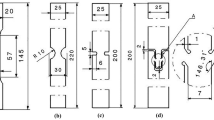Abstract
Based on the numerical simulation, the deformation characteristics of incremental sheet punching (ISP) of perforated sheet with circular holes was studied. Combined with the experimental results, the feasibility of using the normalized Cockroft-Latham ductile fracture criteria to predict fracture of perforated sheet during the ISP process was verified. On the basis of above, the influence of the geometric parameters of perforated sheet on the formability was studied. The main conclusions are the major strain is much greater than the minor strain at the interval of holes on the side wall of the perforated sheet; the thickness at the short-axis edge of the hole is smaller than that at the long-axis edge obviously; and the maximum value of major strain of perforated plate decreases with the increase of straight diameter center distance ratio. It is feasible to predict fracture of perforated sheet during the ISP process by numerical simulation with normalized Cockroft-Latham ductile fracture criteria.























Similar content being viewed by others
References
Ambrogio G, Palumbo G, Sgambitterra E, Guglielmi P, Piccininni A (2018) Experimental investigation of the mechanical performances of titanium cranial prostheses manufactured by super plastic forming and single-point incremental forming. Int J Adv Manuf Technol 98(5-8):1489–1503
Gupta P, Szekeres A, Jeswiet J (2019) Design and development of an aerospace component with single-point incremental forming. Int J Adv Manuf Technol 103(9-12):3683–3702
Saidi B, Giraud Moreau L, Mhemed S, Cherouat A, Adragna PA, Nasri R (2019) Hot incremental forming of titanium human skull prosthesis by using cartridge heaters: a reverse engineering approach. Int J Adv Manuf Technol 101:873–880
Schreiber RG, Schaeffer L (2018) Manufacture of absorber fins for solar collector using incremental sheet forming. J Mater Res Technol 8:1132–1140. https://doi.org/10.1016/j.jmrt.2018.07.018
Schafer T, Dieter Schraft R (2005) Incremental sheet metal forming by industrial robots. Rapid Prototyp J 11(5):278–286
Vihtonen L, Puzik A, Katajarinne T (2008) Comparing two robot assisted incremental forming methods: incremental forming by pressing and incremental hammering. Int J Mater Form 1(S1):1207–1210
Luo Y, He K, Du R (2011) Investigations on the formability of incremental punching process. J Adv Mech Des Syst Manuf 5(4):227–239
Sedighi M, Riahi M, Asgari A (2015) An analytical method for prediction of the incremental sheet metal punching process. Int J Adv Manuf Technol 78(1-4):231–238
Wang J, Li L, Jiang H, Zhang Z, Zhang S (2017) Incremental sheet punching on the base of sinusoidal tool path. Int J Adv Manuf Technol 89(9):3527–3534
Liu Z (2018) Heat-assisted incremental sheet forming: a state-of-the-art review. Int J Adv Manuf Technol 98(9-12):2987–3003
Al-Ghamdi KA, Hussain G (2016) SPIF of Cu/Steel clad sheet: annealing effect on bond force and formability. Mater Manuf Process 31(6):758–763
Sakhtemanian MR, Honarpisheh M, Amini S (2017) Numerical and experimental study on the layer arrangement in the incremental forming process of explosive-welded low-carbon steel/CP-titanium bimetal sheet. Int J Adv Manuf Technol 95:3781–3796
Honarpisheh M, Mohammadi Jobedar M, Alinaghian I (2018) Multi-response optimization on single-point incremental forming of hyperbolic shape Al-1050/Cu bimetal using response surface methodology. Int J Adv Manuf Technol 96:3069–3080
Tayebi P, Fazli A, Asadi P, Soltanpour M (2019) Formability analysis of dissimilar friction stir welded AA 6061 and AA 5083 blanks by SPIF process. CIRP J Manuf Sci Technol 25:50–68
Hirt G, Ames J, Bambach M, Kopp R, Kopp R (2004) Forming strategies and process modelling for CNC incremental sheet forming. CIRP Ann Manuf Technol 53(1):203–206
Nguyen D-T, Park J-G, Kim Y-S (2010) Ductile fracture prediction in rotational incremental forming for magnesium alloy sheets using combined kinematic/isotropic hardening model. Metall Mater Trans A 41(8):1983–1994
Li J, Li S, Xie Z, Wang W (2015) Numerical simulation of incremental sheet forming based on GTN damage model. Int J Adv Manuf Technol 81:2053–2065
Gatea S, Lu B, Chen JOH (2018) Investigation of the effect of forming parameters in incremental sheet forming using a micromechanics based damage model. Int J Mater Form 12:553–574
Elangovan K, Narayanan CS, Narayanasamy R (2011) Modelling the correlation between the geometrical features and the forming limit strains of perforated Al 8011 sheets using artificial neural network. Int J Mater Form 4(4):389–399
Chen FK (1993) Analysis of plastic deformation for sheet metals with circular perforations. J Mater Process Technol 37:175–188
Oh SI, Chen CC, Kobayashi S (1979) Ductile fracture in axisymmetric extrusion and drawing—Part 2: workability in extrusion and drawing. J Manuf Sci Eng 101(1):36–44
Cockroft MG, Latham DJ (1968) Ductility and the workability of metals. J Inst Met 96(2):33–39
Zhang S, Wang J, Shi J, Zhang X, Zhang Z (2016) Incremental forming performance of retiary sheet metal. Forging Stamping Technol 40(03):48–52 in Chinese
Funding
This work is supported by Key Technology Research and Development Program of Shandong under Grant No. 2019GGX102023 and the National Natural Science Foundation of China under Grant No. 51205217.
Author information
Authors and Affiliations
Corresponding author
Additional information
Publisher’s note
Springer Nature remains neutral with regard to jurisdictional claims in published maps and institutional affiliations.
Rights and permissions
About this article
Cite this article
Li, L., Wang, J. & Zhang, S. Numerical simulation for deformation characteristics and fracture prediction of perforated sheet in incremental sheet punching. Int J Adv Manuf Technol 110, 1415–1427 (2020). https://doi.org/10.1007/s00170-020-05908-4
Received:
Accepted:
Published:
Issue Date:
DOI: https://doi.org/10.1007/s00170-020-05908-4




